United Families and Friends
Downing St, Westminster, London. Sat 31 October, 2009
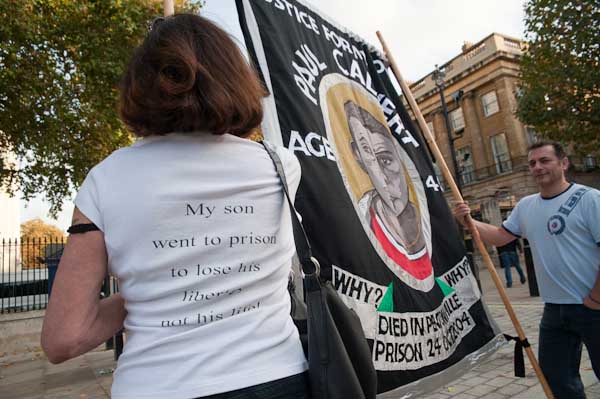
"My Son (Paul Calvert) went to prison to lose his liberty not his life!"
more pictures
Over the past years, the march by the 'United Friends and Families'
of those who have died in suspicious circumstances in police custody, prison
and 'secure' mental health facilities has become an annual event, making its
way at a funereal pace in silence inch by inch down Whitehall to halt outside
Downing Street for an angry protest before continuing noisily to a final rally
in Parliament Square.
At last year's event a large banner was carried with 2500 names of those
known to have died over the years, including 182 in the previous year, and
among those taking part were the mother and other family members of Jean Charles
de Menezes. It seemed then an added insult that the police insisted on searching
all the bouquets before allowing them to be laid at the gates of Downing St
in what I described as "a surreal manifestation of anti-terrorist
paranoia."
A decision was made not to hold a march this year, but it was suggested that
some of the families might meet to hold a demonstration, and on Saturday afternoon
a number of them came to Whitehall for a protest opposite Downing St.
Although some of the cases would appear to have involved deliberate acts
of violence and others a woeful lack of the care required, those responsible
for these deaths have seldom been brought to justice or even reprimanded for
their actions. Where investigations have been held, they have often been seen
largely as ineffectual or designed to cover up offences committed by police
and prison officers.
Among those present were the family of Sean Rigg, who died after
being taken ill in police custody in Brixton Police Station on Thursday 21
August 2008, and Ricky Bishop died in the same police station after
being arrested during "Operation Clean Sweep" on November
22, 2001, an action described by some as a "modern day lynching."
Paul Coker was arrested violently at his girlfriends flat after
a noisy argument early in the morning of 6 Aug 2005. According to The
Guardian, his girlfriend told police that they had settled their differences,
but as they arrested him in another room she heard him violently screaming
"You are killing me. You are killing me" and then things
suddenly went quiet. A neighbour reported he was not struggling as he was
carried out. The CPS report which decided there was insufficient eveidnce
to bring charges states that a doctor was called to Plumstead Police Station
where Paul was taken, but there was a delay as he treated injured police before
he took a look through the cell door and told police to call an ambulance.
After this arrived there was a further delay waiting for a police escort,
and the ambulance crew were asked to check Paul - the first actual medical
attention he got. But it was too late, his heart had stopped and efforts at
resuscitation failed.
Jason Oscar McPherson from East Acton was in a car that was stopped
by police off Ladbroke Grove on 18 Jan 2007, and taken to Notting Hill Police
Station. A healthy 25 year old, within hours he was taken by ambulance to
nearby St Mary's Hospital, dying there late that night.
I first photographed Pauline Campbell a few months after the death
of her daughter Sarah in Styal prison in 2003, and was deeply moved.
She went on to devote the rest of her life to a campaign not just for justice
for her daughter but on behalf of all prisoners, particularly women in prison.
I got to know her better after photographing her being assaulted by a police
officer at a demonstration outside Holloway Prison after the death there of
24 year old of Jaime Pearce, the eighth woman to die in jail in 2007,
after which we exchanged many e-mails. Her own suicide, at her daughter's
graveside in May 2008, moved me strongly, and I felt moved again at seeing
the banner with her daughter's image.
On a lamppost on the opposite side of the road, right in front of the Downing
Street gates the families had taped a single rose and A4 sheets about three
of those who have died. One was simply a photograph of a healthy, athletic
looking young man with the caption 1960 LEON 1992. Leon Patterson
died in police custody in Manchester.
Below it on a sheet above a photograph of another young man, Jason Thompson,
who died in Swansea prison at the age of 26 five years ago on 1 Nov 2004,
was a story written by an eleven-year-old girl that brought tears to my eyes,
"The person who changed my life." Here is a part of it:
"In 2004 my brother died in prison, but he wasn't suppose to be
in prison, the police had got the wrong person it was suppose to be my brother's
friend. I was only 6 when Jason (my brother) died. I went to Jason's funeral
because he was my big brother and while I was at the funeral I cried and cried
and cried. After the funeral I was still crying basically every day, even
now I still get up set... He changed my life when he died it made me feel
like there was a hole in a part of my life. That's what happens when someone
you love dies, it is the worst feeling ever."
On the opposite side of the post was a picture of the mother of Paul Calvert
and his son at a demonstration, holding a picture with a photograph of his
father and the words "Justice for my Dad. Why? Paul Calvert died
Pentonville Prison 24 October 2004."
Paul Calvert was 40, and although the original charges made against him had
been dropped he was arrested for being in breach of his bail conditions. Two
days after being put into Pentonville he hanged himself. He had actually pressed
the emergency button for help, but the alarm bell had been taped over to mute
it and the warning light outside the cell was ignored for 40 minutes, allegedly
because the officer in charge was playing Backgammon.
Across the road, his mother was holding a banner calling for 'JUSTICE FOR
MY SON" and on the back of her t-shirt was the message "My son
went to prison to lose his liberty not his life!"
more pictures
Be With an Angel
Tragalgar Square, London. Sat 31 October, 2009
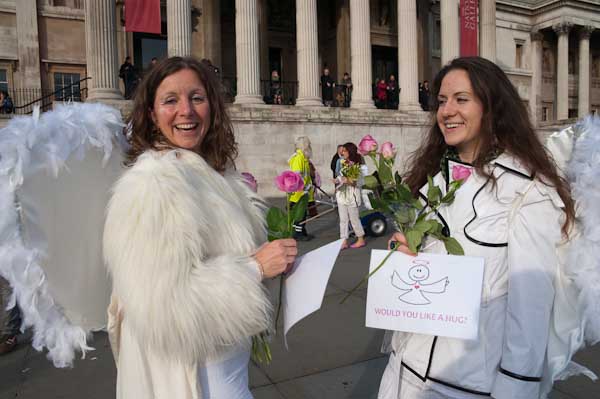
Angels were giving out flowers, hugs and messages of love in Trafalgar Square
as passed through.
more pictures
You may well have spent the week from 26Oct ot 1Nov without being aware that
it was 'Angels Week' an international spritiual mission of which the London
event was organised by the Tara Yoga Centre. This is a part of an international
movement, The Movement for Spiritual Integration in the Absolute
(M.I.S.A.), that started in Romania and has centres which give yoga courses
in around 25 countires around the world.
I'm not sure which of the Angels of Love, Compassion, Wisdom, Patience, Courage,
Happines or Harmony who gave me a hug and a small message of love, a picture
of an angel on the reverse of which was written "I purify my mnind
by affirming my worth and honouring my choices for love." Unfortunately
it didn't have a desirable effect on my own soul mate when I hugged her on
arriving home and handed it over. Probably I should have taken the flower
I was offered in its place, or perhaps she is just a hard case. Most of those
who I saw stopped in Traflagar Square seemed ot be amused and intrigued, though
there were some who turned away to avoid the angels and archangels.
I was just a little worried to find that the archangels all had male names
- Raphael, Metatron, Uriel and Gabriel. I hope its not a sign of some gender-based
heirarchy in heaven.
more pictures
Moderates Protest against March4Sharia
Picadilly Circus, Sat 31 October, 2009
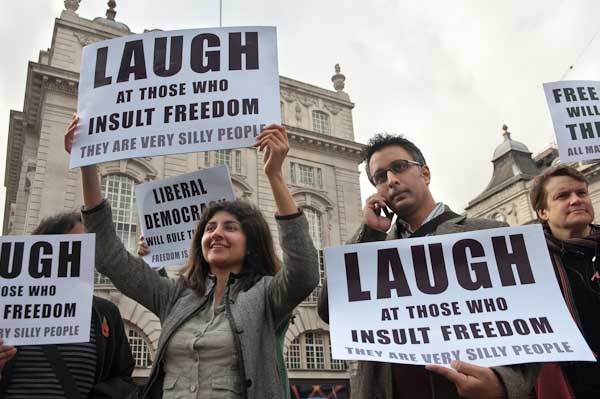
Organised by the British Muslims for Secular Democracy, the protest included
a wide range of British moderates, including some who had simply read about
the event in a Guardian feature. More text below
more pictures
Right Wing Protest against March4Sharia
Picadilly Circus, Sat 31 October, 2009
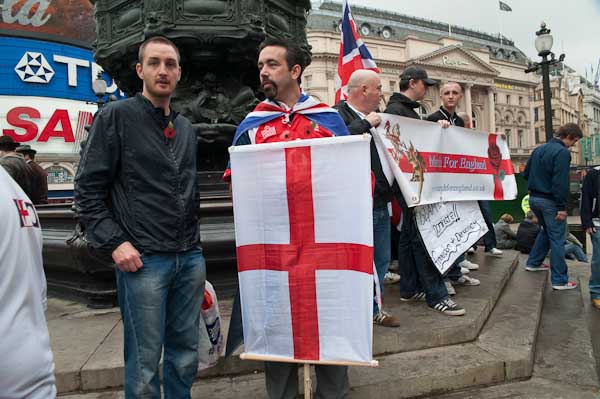
Various right wing groups were represent in the demonstration
around Eros, including the March For England, the EDL and the English Democrats
more pictures
Although the organisers of the MARCH4SHARIAH had issued a press release the
previous day announcing the cancellation of their proposed march "unique
march in Central London which aimed to highlight the superiority of the Shari’ah
over that of British democracy and man-made law", two groups of demonstrators
still turned up at Piccadilly Cricus on Saturday to show their opposition.
The proposed march had been condemned fairly widely both by Muslims and non-Muslims
across the political spectrum in the UK. Its organisers were Islam4UK, which
describes itself as a platform for al-Muhajiroun, an organisation that dissolved
itself after the UK government announced its intention to ban it (and its
two succesor organisations were then banned under the Terrorism Act, and its
founder Omar Bakri Muhammad was banned from re-entering Britain.)
A public debate on Sharia Law in London in June 2009 at which former al-Muhajiroun
leader Anjem Choudary of Islam For the UK planned to relaunch al-Muhajiroun
had to be abandoned after the owners of the hall refused to allow the forced
segregation of men and women which was being enforced by al-Muhajiroun security
guards.
Some of the groups planning to oppose the march, including Muslims4UK and
The Islamic Society of Britain, called off their planned counter-demo, but
supporters of other groups including British Muslims for Secular Democracy,
the English Democrats and March For England and possibly a few from the EDL.
Later I heard reports that more of the EDL had been wandering around the Parliament
Square area where the March4Shariah had been planned to start.
The atmosphere at Piccadilly Circus was quiet and friendly and although there
were several police vans down the street there was nothing for them to do.
The right wing demonstrators talked and gave interviews in which they were
insistent that they were not racist or opposed to Muslims in any way, but
simply opposed to the imposition of sharia law in the UK. For the most part
the two groups of protesters kept a few yards apart, but some of the English
Democrats and others did come to talk with the Muslim groups. One young man
who did express a racist view was rapidly told by his friends he was out of
order.
Moderate Muslims also object the interpretation of sharia by Islam4UK and
al-Muhajiroun and their desire for Britain to become a part of a universal
caliphate govverned by sharia law. Nor would the great majority of Muslims
here be in favour of most of the other ideas on the Islam4UK web site such
as their aim to see Buckingham Palace converted into a "beautiful mosque",
the Queen forced to wear a burkha, the replacement of Nelson's statue with
"an exquisitely constructed Islamic clock" and "the banning
of indecent organisations that are deemed anti-Islamic" from holding
processions, demonstrations and concerts in Trafalgar Square.
Right-wing British newspapers use views like this, put forward by a tiny
minority, to stir up hatred against all British Muslims, the vast majority
of whom equally opposed to them as the rest of the population.
more pictures - Right Wing groups
more pictures - Moderates
Protest Ride at Westminster Bike Parking Charges
Picadilly Circus, Sat 31 October, 2009
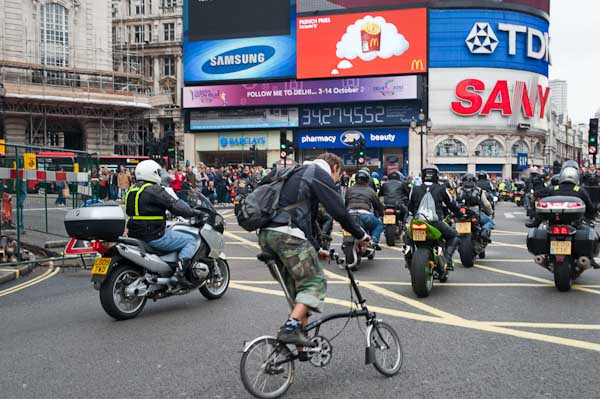
A Brompton joins in at Piccadilly Circus
On Saturday afternoon a large fleet of motorbikes toured Central London on
their way to a protest meeting outside Westminster council offices near Victoria
Station. It was hard to know quite how many, but my guess would be that there
were perhaps a thousand riders. One of the leading bikes carried a tall banner
reading 'No to the Bike Parking tax' and many of the riders wore fluorescent
tabards with the same message on the back.
It was around the 15th such demonstration by bike riders since Westminster
City Council decided to introduce parking charges for motorbikes as an 'experimental
measure' a little over a year ago. Bikers see the scheme as a 'stealth tax'
and the start of charging for parking that will spread to towns and cities
across the country. The charges are collected through a phone-based parking
scheme which Westminster is hoping to sell to councils around the country
and they allege that bike parking fees are an attempt to make the Partners
in Parking (PiP) scheme more marketable because of the increased revenue.
In the first year of operation the campaign says that the council collected
£2.5 million but only spent £300k in what was described as a revenue
neutral scheme.
In a review in June 2009, the council acknowledged the receipts had been
significantly greater than expected and reduced the fees - from £1.50
to £1.00 per day or £150 to £100 per year. They also made
parking at all dedicated off-street bike bays free, and have roughly doubled
the number of these to over a thousand. Westminster resident’s annual
car parking permit holders can also now park their motorcycle for free on
dedicated motorcycle bays across the city, and it seems a ridiculous anomaly
that the price of this permit for a car under 1200cc at £85 is less
than that of a motorcycle permit. Get an 'eco vehicle' and you can apparently
park it and your bike for free!
The pressure from the demonstrations may well have contributed to the council's
changes, but the protesters want a complete removal of charges. They point
to the efficient use of roadside space as 8 bikes can park in the same space
as a car and the reduction in overall congestion if motorbikes (or rather
P2W - powered 2 wheelers) replace cars, and feel the council should be promoting
their use rather than taxing them.
Of course P2Wm while less so than cars, are also in general contributing
to congestion, pollution and global warming - some of the larger bikes having
engines that produce similar amounts of carbon dioxide. Westminster does promote
the use of fully electric motorbikes by allowing them to park free in motorcycle
bays so long as they register annually on-line. The council could certainly
do a lot more to promote greater use of the least polluting of all vehicles,
the pedal cycle, one of which suddenly appeared in the middle of the demonstration
as it passed.
more pictures
Zombies Storm Westminster - Vote for a Change
Parliament Square, London. Friday 30th October
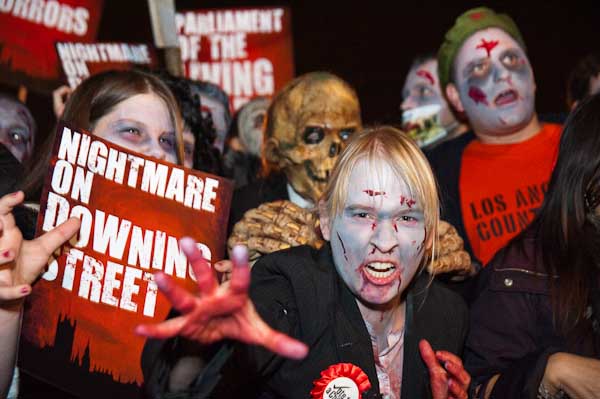
Zombies pose in Parliament Square
more pictures
There are those who think that most days, or at least when Parliament is
in session, that Westminster is full of zombies, and perhaps the only way
to understand the whole expenses scandal that has engulfed the government
(and diverted reporting from a number of more important issues) is to see
that it has unlocked a pent-up flood of hate built up by the mindless lobby-fodder
over the past years.
So it seemed particularly appropriate to have a protest calling for electoral
reform with shambling zombies as a 'Zombie Parliament' at Halloween. It was
orgainsed by the 'Vote for a Change' campaign, which is campaigning for a
referendum on the voting system believing that politics is too important to
be left to the politicians. Around fifty people turned up on Friday night
at the start of the event, many dressed as undead politicians and posing for
photographs as a Parliament of the Living Dead in Parliament Square. From
there they crossed the road and began to climb the fence into Parliament,
but then changed their mind and decided to go up Parliament Street and Whitehall
and pay a visit to their leader in Downing Street, but at this point I left
them to go home.
Among the zombies was Peter Tatchell, who along with many of the others there
was intending to continue to Trafalgar Square and the silent candlelit 'Hate
Crime Vigil' over the increasing number of homophobic attacks in London, and
in particular the brutal attack there on September 25 that killed Ian Baynham.
It is hard to disagree with 'Vote for a Change' that we need to change the
current first past the post voting system, which has led to a parliament dominated
by two parties taking it in turns to hold power and an increasingly presidential
government with MPs whipped zombie-like through votes, largely being kept
in line by the threat of losing their seats.
As they say, our elections have become a choice between two rather similar
parties, each competing for a relatively small number of "swing"
voters in the more marginal seats with very similar policies. And as their
website says, "The current voting system serves to reinforce the stranglehold
of the existing Westminster blocs by depriving small parties of the rightful
share of representation."
The way forward is clearly through some form of proportional representation,
but although Vote for a Change makes some suggestions, they call as a first
step for a referendum on the principle of a change when we vote at the next
general election. This should set a process in motion with a specified date
for the change, with the actual choice of system to be the subject of recommendations
by a suitable body - possibly involving a 'Citizen's Assembly' or an Independent
Commission - with the aim that the reforms be adopted perhaps by 2014.
As they say on their web site, "a fair voting system is not in itself
a sufficient condition for honest politics – other factors such as the
culture of lobbying and the power of corporate interests are also very important."
Electoral reform on its own is not enough to create a healthier democracy
that better reflects the diversity of views in the country. A fairly elected
government must have reforms to deal with these issues as a priority.
more pictures
Critical Mass
Parliament Square, London. Friday 30th October
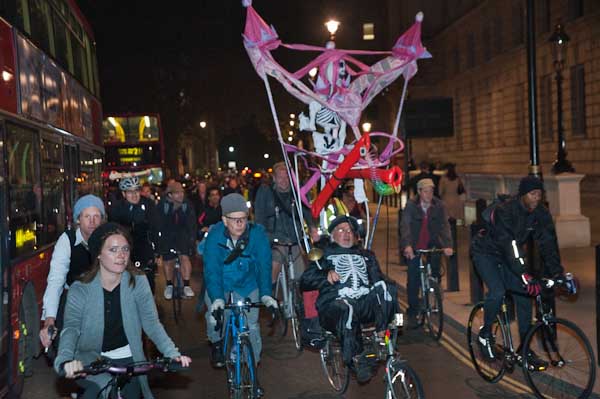
Just a few pictures as the Mass came round Parliament Square
more pictures
Brian Haw Arrested - Released the Following Day
Parliament Square, London. Friday 30th October - Sat 31st October
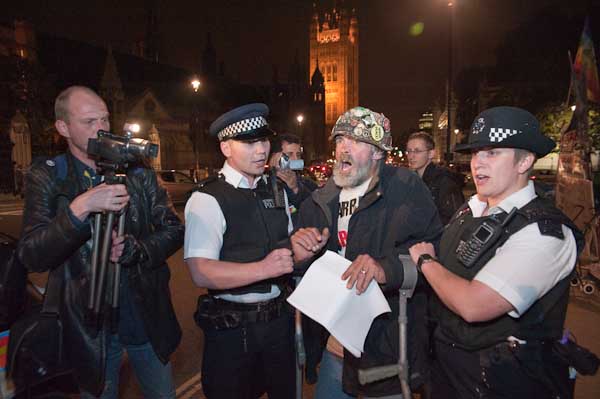
Brian Haw, still arguing, is taken to the police van
more pictures
Police tonight arrested peace protester Brian Haw who has been carrying out
a permanent protest in Parliament Square opposite the Houses of Parliament
since 2 June 2001, 3072 days ago. After a lengthy argument, Mr Haw, who now
walks on crutches, was walked away by two officers, pushed still protesting
into the back of a police van and driven away.
The arrest at around 7pm was witnessed by several of Brian's supporters in
the square, one of whom filmed the event, as well as several photographers
who were present in the square for another protest.
This is not the first time that Brian Haw has been arrested, and throughout
his protest he and his supporters have been subjected to considerable legal
and illegal harassment by the police. The arresting officer is one against
whom allegations have been made by the protesters of misconduct in previous
incidents.
The following morning I went back to Parliament Square to find Brian Haw
was still in custody, and there were two other protesters continuing the vigil.
Following his arrest at 7pm yesterday, he was taken to Belgravia Police Station
where he was held overnight. He was taken to court around middday where police
were forced to release him. There does not appear to have been any substantial
charge, and taking him into custody yesterday appears simply to have been
another round in the continuing harassment of him and his fellow protesters
in Parliament Square by police.
It was good to see him back in his customary place in the square continuing
his protest later in the day - although as we have several times in the past
remarked, a continuing shame on the nation that he still has cause to continue
to protest.
His arrest seems another example of the police being a law unto themselves,
imposing arbitrary temporary periods of detention. Its timing may possibly
be related to next week's parliamentary debate on the Constitutional Reform
and Governance Bill which includes a repeal of the sections of the Serious
Organised Crime and Police Act 2005 and the provision of new powers under
Part 2 of the Public Order Act 1986. Having bothered to read these I don't
feel much wiser about the proposed law and what effect they may have on the
continuing protest in Parliament Square.
The protesters have also been trying to obtain police film footage of incidents
in the square, and the police have so far failed to meet their obligation
to supply this. The latest outrage may be in some way a time-wasting procedure
related to this. The officer who arrested Brian Haw yesterday has also arrested
him on at least one previous occasion and may perhaps have become too personally
involved. It really does seem time that there was a proper and public inquiry
into the policing of this protest over the years and to the role of the particular
officer concerned in this.
more pictures
Halloween Trick or Treat for Goldman Sachs
Fleet St, London. Friday 30th October
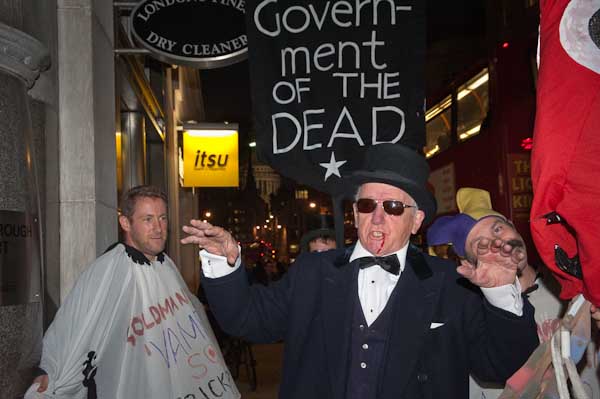
Chris Knight and the Government of the Dead arrive at
Goldman Sachs
more pictures
Although considerably more had shown an interest on Facebook, the Government
of the Dead could only muster six (one of whom arrived just as the event was
finishing) for their "Goldman Sachs Giant Vampire Squid Trick or Treat"
on Friday evening.
By the time the Squid arrived, the bankers had gone home from their Fleet
St offices (formerly a part of the Daily Express site) leaving just a few
security men to stand outside and watch as Chris Knight and company denounced
the company. At least some of the security men were amused by the event, but
by 5.15pm on a Friday the street was surprisingly empty with just a few passers-by
- mainly tourists - stopping briefly to watch.
Wikipedia notes that Goldman Sachs received $12.9 billion from the US Federal
Reserve as a part of the AIG bail out and is still benefiting from over twice
this amount in cheap debt from the US government. Despite this, according
to the Wall Street Journal, in late 2008, it paid bonuses of $3million each
to over 200 employees, $2 million to almost 400 and $1 million to almost a
thousand more. The whole banking system still seems completely out of control,
with those at the top still pocketing bucketfuls of money while sniggering
at the rest of us and the puny efforts of politicians to exert control over
them.
Police kept a very low profile during the event, although obviously Goldman
Sachs were ready and waiting, with more security men inside the building.
After around 20 minutes outside the building the Government of the Dead marched
off towards the city while the three freelance journalists present went off
in the opposite direction.
more pictures
London at Night
London. Friday 30th October
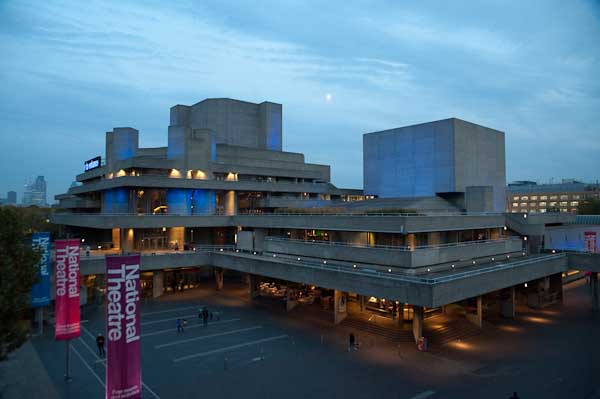
Just a few pictures as I walked through London to the various events
more pictures
Brian Griffin at the NPG
National Portrait Gallery, London. Friday 30th October
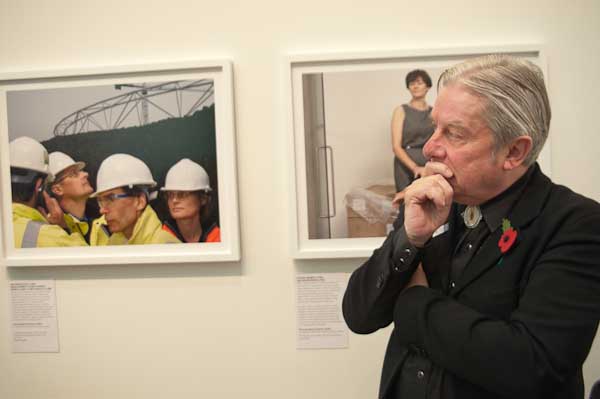
Brian Griffin looks at my favourite image out of his first six for the NPG
project
more pictures
It was apparently 1000 days to the London 2012 Olympics, which our
greatest authority on such things, Professor Peter Hall who in the
early 1990's was the main government adviser on planning in the region is
quoted on Games Monitor
as writing that the games are having "terrible distorting effects
[on the development of the area], apart from the cost of it all, direct and
indirect." I put it more bluntly on >Re:PHOTO
in my post there on the launch of the NPG/BT Road to 2012 Project with
the first 6 of Brian Griffin's pictures for the project (he is to produce
about 20, with commissions still to be awarded to other photographers for
another 80.)
As well as Sandy Nairne, the Director of the NPG, there
were also speeches from Olympic evangelists Lord Coe and Dame
Kelly Holmes, but the event really came alive with quite a different
buzz when Brian Griffin came to the lectern, talking about how and
why he made the pictures.
After the talks we trooped out to see the pictures, and quite a few of those
in them were there, and you can see some in my pictures, along of course with
Brian Griffin and a few other people. There are links to decent copies
of the six pictures in my >Re:PHOTO
piece, as well as to another blog where the photographer writes about his
work.
more pictures
Afghanistan - Bring the Troops Home
Hyde Park - Trafalgar Square, London. Saturday 24 October, 2009
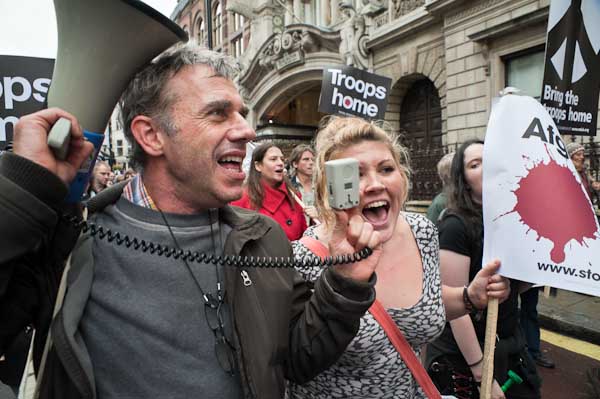
On the march in Piccadilly
more pictures
Perhaps ten thousand came to Hyde Park on a gloomy and slightly damp Saturday
afternoon to take part in a march and rally to demand that British troops
are bought home from Afghanistan now.
At the front of the march to Trafalgar Square was serving soldier Lance
Corporal Joe Glenton with his wife Clare. He marched in defiance
of an order by his commander to return to barracks and not take part in the
demonstration, and already faces a court martial for refusing to return to
fight in Afghanistan. Among the other anti-war military family members marching
was Peter Brierley, father of Lance Corporal Shaun Brierley, killed
shortly after being deployed in Iraq, leaving a widow and a young child. After
the recent commemoration service for the dead of the Iraq war, he refused
to shake Tony Blair's hand when offered to him, saying "Don't you
dare, you have my son's blood on your hands." Also at the front
of the march were a number of veteran peace campaigners, including Pat
Arrowsmith.
The march, organised by the Stop the War Coalition, the British
Muslim Initiative (BMI) and the Campaign for Nuclear Disarmament
(CND), as expected was entirely peaceful, though with some spirited chanting
and a live band, The King Blues, which played on the route it was
quite a lively event. There were many banners from groups around the whole
of the country, including a large contingent from CND Scotland.
At Trafalgar Square there was a rally with speeches from Tony Benn, Jeremy
Corbyn MP, Omar Deghayes, Tariq Ali, George Galloway MP, Lance Cpl Joe Glenton
and others. During the speeches a group of four men dressed in black started
to shout out, and were quickly surrounded by angry demonstrators. Police escorted
them away, followed by several hundred demonstrators who alleged they had
made racist comments. The four men claimed to be Leeds supporters who had
come down for a match with Millwall and after minor scuffles between police
and protesters the four eventually taken away by the police for their own
safety.
more pictures
UAF Protest Racist on BBC Question Time
BBC TV Centre, Wood Lane, London. Thursday 22 October 2009
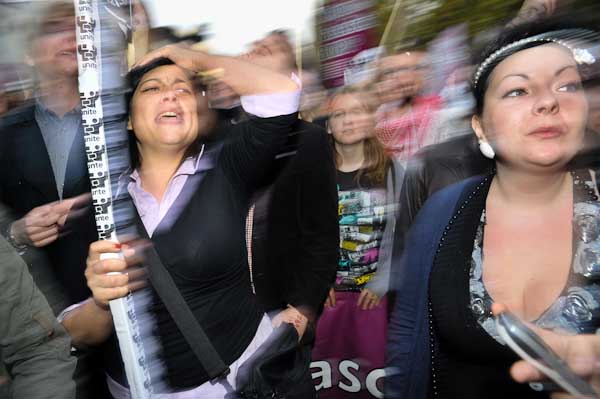
Protesters in the street outside the BBC TV Centre in Wood Lane
more pictures
The main Unite Against Fascism demonstration outside the BBC against
the TV appearance of BNP leader Nick Griffin wasn't due to start until 5pm,
but as I arrived 40 minutes earlier there were already almost a thousand people
there, and a crowd was moving towards the main vehicle gate to enter the premises.
Around twenty people including several photographers went through before
police formed a line and stopped the rush. Most if not all of them were escorted
out a few minutes later, though apparently a few made it to the actual studio.
Meanwhile the rest of the crowd formed a chanting mass in front of the gates.
The crowd then formed up on the side of the road which police were attempting
to keep clear. There was a little pushing and shoving, but mostly it was good-tempered
and the demonstration stewards established a gap between police and protesters
outside the main gate.
The crowd was still growing and police were trying hard to keep the road
past the BBC open, pushing people back onto the pavement. But by a quarter
to five there were just too many to hold and the road was occupied by the
protesters.
A little after 5pm there were loud cheers as one of the organisers reported
that police had told Mr Griffin that they could not guarantee his safety if
he tried to use the normal entrance to the BBC, and he had refused to take
the risk. Later we heard that he was going to try to use a back entrance to
the extensive BBC site, and there were some scuffles as groups of demonstrators
tried to head in what they thought was the right direction to head him off
but were stopped by police.
After I had left there were apparently several arrests and the police used
pepper spray on several demonstrators as well as cutting one guy's head fairly
badly with a baton. In another act of violence, at least one videographer
was trampled by a BBC TV crew. The filming of the Question Time programme
was held up for a couple of hours.
more pictures
World March For Peace and Nonviolence
London, Sunday 18 October 2009
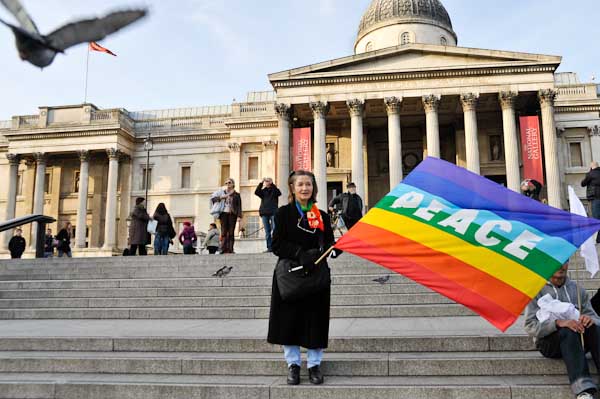
The peace march was prevented from going through Trafalgar Square by the 'heritage
wardens'
more pictures
The
World March For Peace and Nonviolence is a movement that unites
people around the world in their desire for a future in which violence gives
way to dialogue. The March was initiated by the international
Humanist Movement
organisation '
World Without Wars' and it welcomes the participation
of all around the world who share the same aspirations and sensibility and will
be created and shaped by all who take part and the creativity they express.
It started on the 140th anniversary of Ghandi's birth, October 2, 2009.in
New Zealand and includes events all around the world over 90 days until its
conclusion at Punta de Vacas in the Andes Mountains in Argentina on January
2, 2010, where Silo (Mario Luis Rodríguez Cobos) the founder of the
Humanist Movement launched a new campaign for global nuclear disarmament in
September 2006. Alongside the many events in countries around the world, a
base team of around a hundred people selected from volunteers around the world
are travelling from New Zealand to Argentina via Japan, Korea, Moscow, Rome,
New York, and Costa Rica, attending events organised along their route. On
the weekend the march across London was taking place the base team was in
Japan.
Around 50 people took part in the London march, which was held over two days
from 17-18 October. It started with a vigil close to the Northwood Permanent
Joint Forces / NATO Headquarters in Middlesex on Saturday morning, with speeches
by World March UK co-ordinator Jon Swinden, Sonia Azad of Children Against
War and organiser Daniel Viesnik, who also read out a message of support from
John McDonnell MP.
On Sunday the marchers left from Brent Town Hall and I met them as they arrived
at Marble Arch. They stopped for lunch at Speaker's Corner and then took part
in the interactive play 'Let The Artists Die' written and directed by Charlie
Wiseman, who was also one of the three main actors. Very much inspired by
Brecht and Beckett, this experimental work involved the themes of peace, non-violence
and the power of the imagination. Last year his work http://www.sunofhope.org/
Solenoid, created with London youths from estates in Wandsworth, Ladbroke
Grove and Portobello, was dedicated to the victims of violence/gun and knife
crime and to those creating the World March for peaceful and non-violent world.
From Hyde Park the march walked past the front of the US Embassy to the memorial
to the British victims of 9/11 in Grosvenor Square, where it stopped to pay
its respects. Then on through the back streets of Mayfair, where a taxi driver
almost brought it to a halt by deliberately driving into one of the marchers,
and on to Regent St then down to Piccadilly Circus and Trafalgar Square
As the march came down the steps at the north of Trafalgar Square it was
stopped by the 'heritage wardens' who said it could not walk through as it
had not applied for permission. It has never been a place I’ve asked
for permission to walk across, and it seemed particularly perverse that our
city authorities should be applying such a restriction in what has for many
years been a traditional venue for dissent, but this was a peaceful and law-abiding
march, and rather to my surprise, after stopping for a few minutes rest on
the steps it made its way around the side of the square and on into Whitehall.
Walking down Whitehall we passed the Old War Office, and then the statues
of famous generals outside the "Defence Ministry" (governments were
more straightforward with language in the past), opposite the fortified gates
of Downing Street and on to Parliament Square, where the march stopped at
the permanent peace protest by Brian Haw there since 2 June 200l with the
help of his supporters.
From Westminster the march, which included a small group of Buddhists, continued
to its end at the Peace Pagoda in Battersea Park, but I left them to take
the train home.
It was, as you can see from the pictures, a small protest, but part of a
much larger international movement, with other marches taking place across
the world.
more pictures
Ridley Road Market: Worldbytes Defends Right to Film
Ridley Rd, Dalston, London. Sunday 18 October 2009
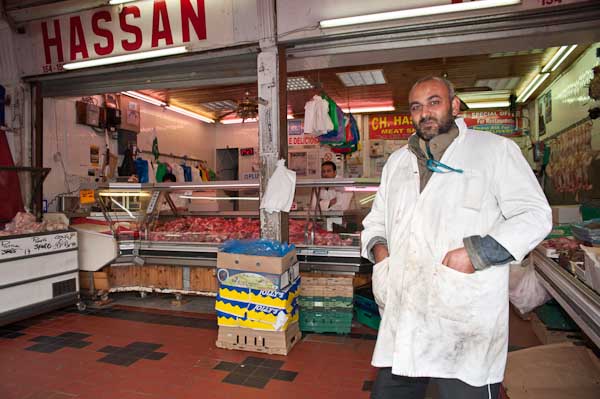
Halal butcher in Ridley Road market, Dalston
more pictures
On Sunday morning in Hackney, Worldbytes was going to places in the borough
where their teams have run into trouble making films. The problems seem to
come from the local council, whose employees tell the young film-makers that
they need permission to film and take photographs even though they are working
in public places.
Of course this is simply not true, and it's no business of the council. So
I was very happy to go along and support their action. But important though
it is to uphold the right to photograph in public places, I was also interested
to take another look at Ridley Road market and to take some pictures there
myself.
Hackney Council didn't bother us - their staff probably don't work Sundays
- and I had no problems photographing in the market. One or two people did
refuse when I asked if I might take their picture, and I simply went elsewhere,
but otherwise there were no problems while I wa their - other than being interviewed
by Worldbytes! You can read more about the protest on >Re:PHOTO.
more pictures
Protest against Forced Deportation of Iraqi Refugees
Parliament Square, London. Saturday 17 October, 2009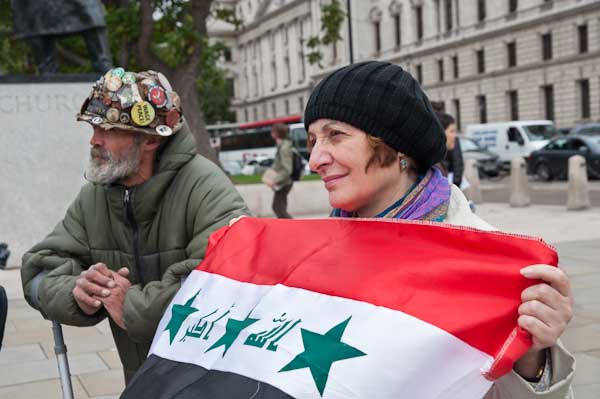
The familiar face of Brian Haw, whose protest has continued
in Parliament square since June 2001
more pictures
On Saturday 17 October a demonstration in Parliament Square called for an
end to the forcible deportation of refugees back to countries where their
lives or freedom were threatened, and in particular to Iraq. Speakers pointed
out that the UK was disregarding its obligations under the UN Convention on
refugees, and that the Court of Appeal had ruled that its treatment of them
was in breach of its EU obligations. I arrived late and missed many of the
speeches, including phone calls from some of those who had been flown to Iran
earlier in the week but returned to the UK.
Among those who spoke at the event (and probably the only person who could
lawfully use a megaphone there under the SOCPA which bans and limits protests
in the area around Westminster) was veteran peace campaigner Brian Haw, still
continuing his protest in Parliament Square after more than 3000 days (over
8 years since 2 June 2001) and various legal and illegal attempts by police
and others to oust him. Now walking with the aid of crutches he still showed
the fighting spirit that has kept him going "for as long as it takes."
The emergency demonstration came after the UK Border Agency had forcibly
removed 44 refugees and put them on a chartered flight to Baghdad with over
twice as many security guards. The Air Italy flight was the UK’s first
attempt at a forcible mass deportation flight to southern Iraq, although previously
similar flights have returned around a thousand refugees back to the Kurdistan
Regional Government-controlled region in northern Iraq, where conditions are
less dangerous.
At Baghdad airport, an army officer with seven armed guards came on board,
and he asked the immigration officers on the plane why they had brought the
men there. He asked the refugees if they wished to return, and ten who agreed
were allowed to leave the plane. The officer told Immigration officers not
to attempt to bring people by force again, and they were flown back to Italy
and later on another flight to this country were they were returned to an
immigration detention centre near Gatwick.
The ten who did leave the plane in Baghdad had been promised help from the
British Embassy there. All they got was a small cash payment before being
left on the street. Overseas papers have published claims that they were mainly
or entirely from the Kurdish areas in the north, and thus should not have
been sent back via Baghdad, as well as suggesting that many left on the plane
were not Iraqis at all but Egyptians or Palestinians.
The forcible repatriation attempt was condemned by human rights groups in
the UK, both for being inhumane and in breach of the our legal and moral obligations,
but also because the way in which these removals are carried out deprives
the detainees of their legal rights. They are given no advance warning of
the actual date of their removal and then taken early in the morning and prevented
from contacting their legal representatives who are thus unable to lodge a
final last-minute appeal.
According to Caroline Slocock, Chief Executive of the charity Refugee and
Migrant Justice, the recent Court of Appeal decision that the government has
failed in its duty “to grant protection to people fleeing indiscriminate
violence … is likely to lead to many more Iraqis gaining the right to
stay once the asylum courts review specific conditions in Iraq in the next
few months.” It seems as if the Borders agency is trying to get rid
of all it can before this happens.
Despite the embarrassing rebuff, the Border Agency is busy making plans to
return these and other refugees on forced flights to Iraq, and Chief Executive
Lin Homer claimed that the return of the 10 who were admitted "is an
important first step for us."
Denmark and Sweden were both criticised last month by the United Nations
High Commission for Refugees (UNHCR) criticised for forcibly returning people
to Iraq,, where their lives or freedom could be threatened. The Borders Agency
seem also to be ignoring the UK Foreign Office travel summary, updated as
recently as 1 October 2009, which states "We advise against all travel
to Baghdad and its surrounding area."
more pictures
National Anti-Fur March and Rally
Knightsbridge, London. Saturday 17 October 2009
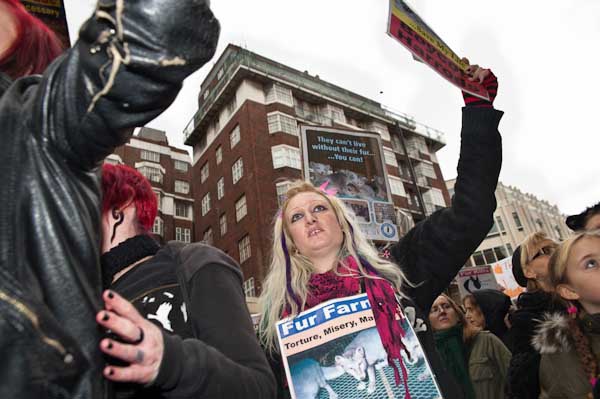 The
climax of the march came at Harrods, the only department store in the country
still selling fur
The
climax of the march came at Harrods, the only department store in the country
still selling fur
more pictures
Despite the many exposes of the excessive cruelty involved in producing animal
fur either by farming or by trapping, there are still some fashion designers
who are prepared to use fur in their designs - and still a few women who care
so little about cruelty to animals that they are prepared to wear them.
Several hundred turned up for the National March Against the Fur Trade in
London on Saturday, Oct 17 2009, organised by the Coalition to Abolish the
Fur Trade. It was the start of National Anti-Fur Week with involves protests
and street stalls against the fur trade around the country.
Among the shops on the route of the march were Fendi, Gucci and Armani, Escada,
Joseph, and Harrods, the only department store in the UK that still sells
fur.
It was a noisy, angry but not unruly demonstration, and while there was a
large police presence (particularly around Harrods) the policing had a lighter
touch than in recent years, though there was still a police FIT photographer
taking a great many pictures. Police did this year allowed some leafleting
on the streets as the demonstration went along, although the majority of marchers
were kept on the road and prevented from handing them out. This does seem
an arbitrary and unfair restriction on the right to protest - which the police
have a duty to uphold. Many shoppers on the busy pavements - and those inside
the shops we passed - did stop to watch, and most of those who did get leaflets
seemed sympathetic.
The climax of the event was outside Harrods, where the march stopped for
a short address after which there was a minute of silence, followed by an
impressive barrage of noise.
In previous years I've had problems with the police while covering the Anti-Fur
March, with police enforcing a strict cordon, refusing to allow me to enter
or leave the march despite showing a press card. This year photographers appeared
to be allowed the freedom we need to get on with the job, although there were
very few present.
The UK Labour Government fulfilled an election pledge by banning fur farming
in the Fur Farming (Prohibition) Act 2000, though it only came into force
at the start of 2003.
Some countries have passed laws providing improvements in animal welfare
in fur farms, and the result has always been that farms in those countries
close down. Ethical fur farming simply is not economically viable, and you
can be certain that any animal fur sold in the fur trade has been produced
by cruel methods. Much now comes form China. It is hard to believe quite how
cruel some of the practices are; in some cases the animals are skinned while
still alive.
Having accepted that fur farming (and of course fur trapping) involves considerable
cruelty to animals it seems illogical that the trade in fur should remain
legal in this country.
Although long campaigns against fur because of the cruelty involved have
made the wearing of fur coats unacceptable to most, in recent years some parts
of the fashion trade have made increasing use of fur trimmings to garments.
Many designers have stopped using fur, but some of the big names still do,
and the protest in Knightsbridge, one of the most exclusive shopping areas
of London, today drew attention to some of them. Fur is valued not because
of any particular properties, but simply because - even when farmed with excessive
cruelty - it is expensive; a way that the rich and stupid can show how rich
(and stupid) they are.
more pictures
Tamils March Against Sri Lanka Concentration Camps
Embankment, London. Saturday 17 October 2009
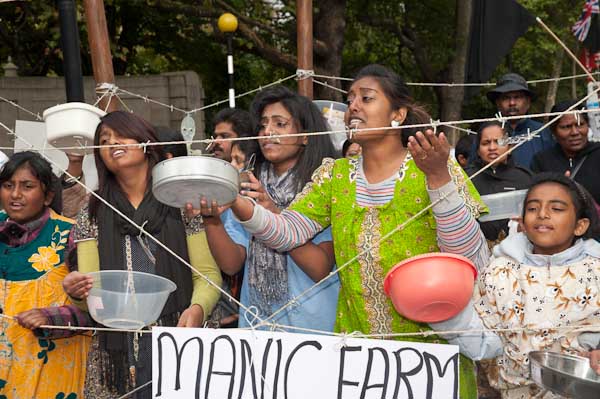 Manic Farm 'concentration camp' on the protest
Manic Farm 'concentration camp' on the protest
more pictures
Several thousand Tamils marched through the centre of London today to protest
against the continued illegal detention of over 280,000 Tamil civilians -
including at least 50,000 children in miserable and squalid conditions in
camps run by the Sri Lankan military.
At the head of the march was a small 'camp' with posts and 'barbed wire'
holding a number of protesters, and in front of it several 'hooded detainees'
were harangued and threatened by 'Sri Lankan Army' guards.
Reports from the camps in Sri Lanka are limited, as the Sri Lankan government
severely resticts access by aid agencies and international monitors and the
internaitonal media, but they have told of crowded tents, inadequate sanitation
- with one toilet for every 200 refugees, inadaquate water supplies and food,
and indaquate medical facilities, with widespread malnutrition and jaundice
and other diseases spreading fast.
According to 'The Times', more than 1400 people die every week inside the
camps, and they are certainly very much overcrowded, with Amnesty International
reporting a population numerically equivalent to that of Bournemouth being
confined in an area the same as Wembley Stadium.
In a letter to Prime Minister Gordon Brown, the British Tamils Forum, organisers
of the protest, detailed their deep concerns, pointing out that allthough
the Sri Lankan government had announced that it would release 80% of the detainees
within 180 days, more than 150 days later only round 20,000 of the 300, thousand
- around 7% - have been released.
The situation in the camps is unbearable, and in one recent incident six
unarmed people including a woman and three children were shot as they tried
to escape. They warn that conditions will worsen dramatically with the impending
monsoon season, as the camps are expected to flood.
They also accuse the Sri Lankan military of massacring over 20,000 Tamil
civilians in the last few days of the war and of now systematically destroying
the evidence of this in an attempt to avoid war crime prosecutions.
The Tamils have completely lost confidence in the UN Secretary General Ban
Ki-Moon, who failed to take any action to save the refugees trapped in the
'Safe Zone' who were killed in the shelling. They ask that the international
community should actively obejct to his reappointment as General Secretary.
The protest also called on the UK government to demand :
- that Sri Lanka immediately release the Tamil people, and give full access
for the UN, Red Cross and aid agencies to the camps to help them return
to where they choose to live.
- that a full list of those detained is published - many families do not
know whether their missing members are still alive.
- that those detained as alleged LTTE (Tamil Tigers) be treated according
to international law and be given access to legal representation,
- a full independent international investigation into war crimes
- an end to activities such as building Buddhist temples designed to destroy
the character of the Tamil areas.
The demonstration was considerably smaller than the massive Tamil demonstrations
seen in London before the defeat of the Tamil Tigers, and the mood was considerably
quieter.
more pictures
Agrofuels Don't ROC(K)
Whitehall, Westminster, London. Mon 12 Oct, 2009
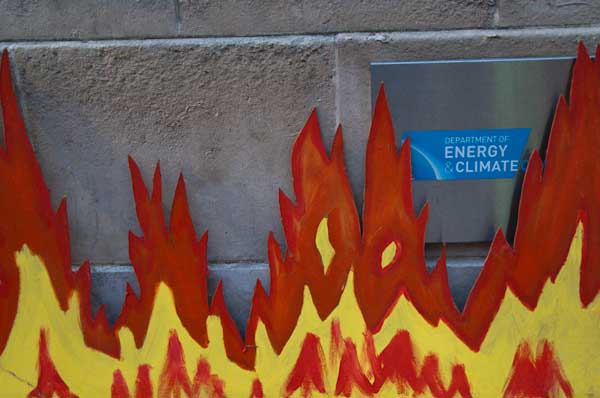
The Department of Enengy & Climate Change briefly surrounded by flames
- police said remove them
more pictures
Around a hundred protesters turned up for a demonstration at the DECC in
London calling for an end to government subsidies for agrofuels because of
their serious harm to communities and ecosystems and contribution to climate
change.
The 'Agrofuels Don't Roc(K)' demonstration was later joined by demonstrators
who had been demonstrating in the 'Global Mobilisation for Mother Earth'
called by Andean indigenous peoples, also showing their opposition to agrofuel
production.
The UK Government is diverting renewable energy subsidies (Renewable Obligations
Certificates – ROCs) to subsidise power stations that use 'agrofuels'
which are destroying the environment across the world. To make their use economic
they give twice the subsidy to fuel produced from overseas palm oil than goes
to the equivalent amount of energy from wind - one of our major renewable
energy resources. The protest called for these monies to be put to truly green
uses and for an end to biofuel folly.
Agrofuels - crops grown to produce fuel, largely for transport - were once
simplistically seen as part of the solution to the problems of our environment,
but fuller studies have shown that they cause serious harm to the climate,
wreck communities whose land is taken for their growth, destroy biodiversity,
replacing complex natural ecosystems by agro-chemical based monoculture, and
by replacing food crops, cause starvation.
The EU Directive 2003/30/EC which comes into force in 2010, requires all
fuels to have a 5.75% bio content. Based on poor and out of date science,
it will have disastrous results.
Agro-fuels provide a means for industrial countries to continue 'business
as usual' by exporting their environmental problems to the non-industrial
south, buying up land and displacing food production and creating 'biofuel
refugees' of indigenous peoples. A UN source has described it as a 'crime
against humanity.'
Among the speakers was transport campaigner John Stewart, who warned
that the air transport industry see agro-fuels as their salvation of their
industry, allowing them to continue offering cheap flights and increasing
air traffic, while pretending to be green.
The rally was also addressed by a speaker for the 'Global Mobilisation
for Mother Earth' who described the problems faced by indigenous peoples
in Latin America and the unified action by the peoples - the Minga
- "to 'liberate Mother Earth' from the destructive alliance between multinational
corporations and local elites", particularly in mining and agrofuel production,
and the struggle for "a dignified future for their children and their
communities" (quotes are from the Coordinadora Latino-Americana
leaflet.)
more pictures
Greenpeace Parliament Roof Protest Ends
Houses of Parliament, Westminster, London. Mon 12 Oct, 2009
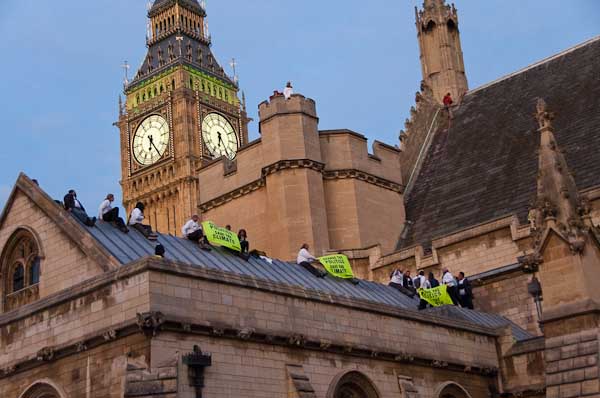
Around 20 protesters visible on the roof shortly before they came down and
were arrested
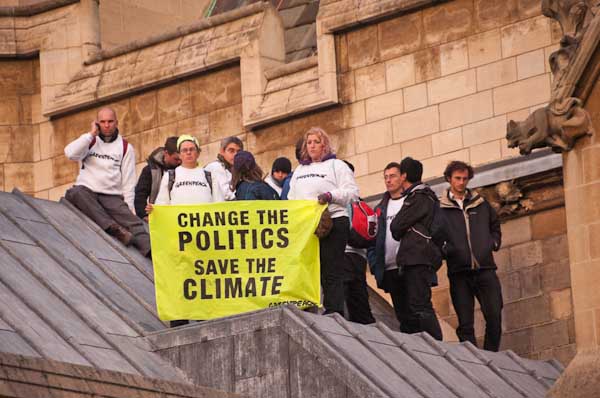 Around a dozen in
one corner
Around a dozen in
one corner
Shortly after I took these pictures, which show protesters still on the roofs
of the Houses of Parliament at around 6.30pm on Monday evening, they came down
after spending around 28 hours there. According to Greenpeace there were 31
of them and they were all arrested. The 24 protesters who had come down on Sunday
night were detained overnight before being bailed
.
Displaying bright yellow banners with the message 'CHANGE THE POLITICS SAVE
THE CLIMATE’ the Greenpeace demonstrators called on the UK Government
to take effective measures to combat climate change, including stopping airport
expansion, a refocus of taxes on pollution, fair financing to help pay for
low carbon development in poorer countries, an increase in government and
private investment in alternative energy and a switch towards renewable energy
and an upgraded grid.
The Greenpeace web site has a list of '12 policies to save the climate and
our planet.' Greenpeace say that current government policies - such as building
extra runways - are locking the UK into high carbon lifestyles and there needs
to be a change to green policies instead of green rhetoric. Their manifesto
shows how we could protect the environment and at the same time protect the
UK economy, making us competitive in a low carbon world. And as they say,
"The International Energy Agency and leading economists agree that failure
to act now will lead to economic as well as environmental disaster."
The Government and most news media rather than discussing the issues the
protest raised on the environment seem more concerned with the breach in security
around the Houses of Parliament that the action appears to have demonstrated.
Frankly it's a vanishingly minor issue compared with the future of the planet.
London Mobilisation for Mother Earth
Embassies of Colombia, Peru & Spain, London. Mon 12 Oct, 2009
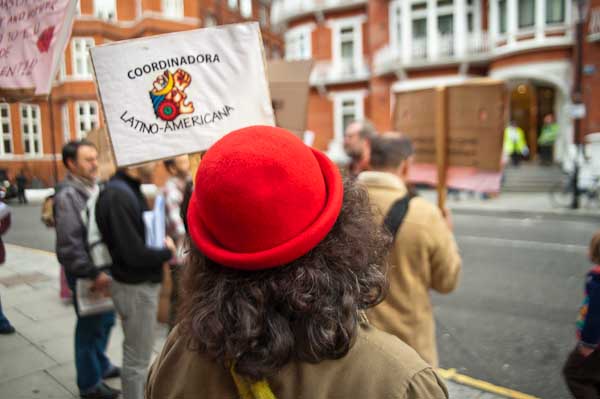
At the start of the protest opposite the Colombian embassy
more pictures
Protesters met in London today as a part of an international day in support
of the struggles of Latin American native people and to protest against the
increasing threat of agro-fuels both to them and, through global warming to
the planet as a whole.
The protest was a part of a Global Mobilisation for Mother Earth called on
the anniversary of Columbus landing on Abya Yala (the Americas), 517 years
ago by the Coordinadora Andina de Organizaciones Indigenas (CAOI). In London
the action supporting the 'Minga'- the collective mobilisation of people from
along the Andes - Colombia, Ecuador, Bolivia, and Peru - marching together
in their refusal to accept the destruction of their land was organised by
the Coordinadora Latino-Americana which unites a number of Latin American
solidarity groups here. It was in particular directed against the European
Union's Free Trade agreements with Latin American countries which will allow
multinational companies to exploit resources on favourable terms, with deals
by Colombia and Peru that will destroy the ancestral territorial rights or
indigenous peoples and also isolate the more progressive governments in the
area, but at each of the embassies it called at there were also specific demands
related to the situation in each country.
The UK, through former EU Trade Commissioner Peter Mandelson and his replacement
Cathy Ashton, have played a leading role in these agreements. The UK government,
while allowing Vestas producing wind turbines to close and failing to support
other green manufacturing in areas such as solar energy, is diverting large
amounts of funding meant for renewable energy projects to the production of
agro-fuels which worsen global warming and threaten food security around the
world. Land in Latin America - as elsewhere in the South - is being taken
over by multinationals for their production, displacing the inhabitants, and
introducing monoculture that destroys biodiversity and rapidly exhausts the
soil.
The protest started with around 30 people at the Colombian embassy, where
they called for an end to human rights violations by state agents and the
violent repression of peaceful protest, as well as a halt on projects with
high environmental impact. They called for the state to respect the rights
of the indigenous peoples and to put them and the land first over economic
interests, and in particular for the government to stop promoting the cultivation
of African palm for bio-fuel and to produce crops to feed the Colombian people.
A letter was delivered to the embassy.
The protest then moved on to the Peruvian Embassy, where we listened to a
clear exposition of the link between opposition to agro-fuels and the indigenous
struggles in Peru by eco-socialist Derek Wall of Green Left, before another
letter was read and delivered to the embassy.
By the time the protest had reached the Spanish embassy it had roughly doubled
in size and more were coming to join it. At this point I left to go to a protest
against Agro-fuels at the Department for Energy and Climate Change, which
the other protesters would join later, after another protest outside the Foreign
Office in Whitehall.
more pictures
John's Birthday Party
Croydon, London. Sat 10 Oct, 2009
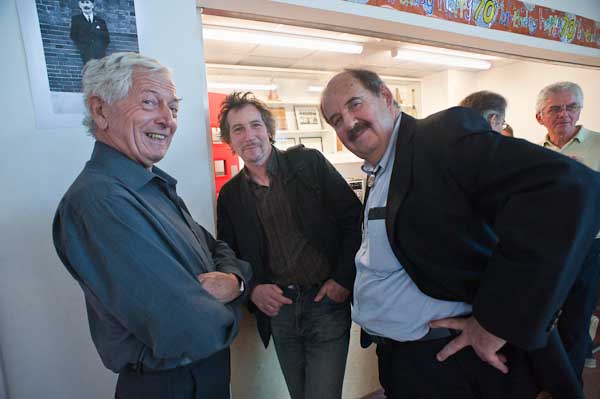
John is at the right of the three photographers at the front, and at top left
is one of his pictures from the '70s
I've written and spoken on a number of occasions about John Benton-Harris
and his great if largely unacknowledged contribution to British photography
both through his own fine work, particularly in the 1970s & 80s - and
he's still going strong - but also through his attitudes to the medium and
the spreading her of the work of many American photographers - most notably
with the 1985 Barbican show that was his baby - though others added some bathwater
and took most of the credit.
A Walk in Cookham Dean
Cookham Dean, nr Maidenhead, Berks. Monday 5 October, 2009
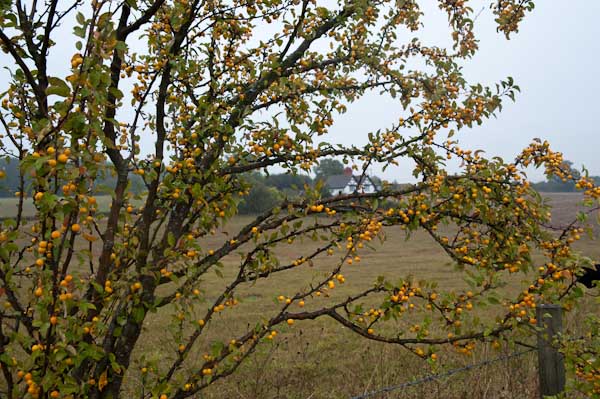
Cookham Dean isn't London, but rich commuter country as well as farmland
more pictures
Cookham Dean - or rather Cookham, just down the hill - is on a branch line
to Maidenhead, only a short drive away. There are a few direct trains to Paddington
for commuters from Cookham taking around 45 minutes, but it can be faster
to if y ou change at Maidenhead. From there you can be in Paddington in 25
minutes or a fraction less, very handy if you work for the BBC or elsewhere
in West London. The only drawback is that the annual season ticket from Cookham
to Paddington will set you back around £2,600 - or if you are coming
from Cookham you'll almost certainly want to pay a few hundred extra to enable
you to sit in First class.
It has a jolly good pub called The Jolly Farmer, bought by the village in
1987 for the village, and we had a nice enough meal there, though in retrospect
I'd advise opting for the more straightforward dishes on the menu as much
better value. It's a free house will several decent beers on tap. As we left
the pub we were reminged not to miss the flower festival which was was in
full swing at the curch of St John the Baptist across the road. It really
was a trip to a different world.
Cookham managed to keep much of its common land in the era of enclosures,
and much around is owned by the National Trust, though the notable views weren't
really that visible through the constant light rain.
more pictures
Photomonth Opening
V&A Museum of Childhood, Bethnal Green, London. Oct 1, 2009
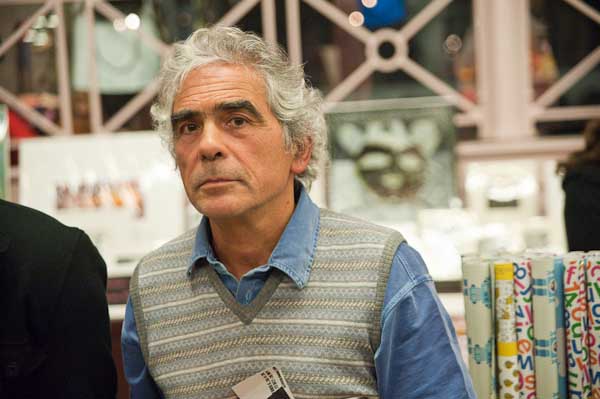 Paul
Trevor looks worried. His pictures of children were the main attraction of
the evening.
Paul
Trevor looks worried. His pictures of children were the main attraction of
the evening.
more pictures
You can read more about
Paul Trevor and his work in my feature on the
opening on
>Re:PHOTO, which also
has most of the photos that I've put here on
My London Diary.
Photomonth2009 was officially opened
at the Museum of Childhood, part of the V&A Museum in Bethnal
Green, an appropriate venue for several reasons. The V&A at South Kensington
site was one of the first museums to collect and buy photography, starting
around 150 years ago, and has one of the finest collections around, accessible
to visitors through their Print Room, as well as occasional exhibitions. It
is a great experience to go there and handle vintage prints by great photographers
such as Eugene Atget, Edward Weston and so many more there.
The buildings that make up most of the Museum of Childhood at Bethnal Green
were actually physically transported from South Ken into East London and opened
in 1872, very much as a part of a mission to bring culture to the masses (a
massive failure which you can read more about in Cathy Ross’s 'The
Romance of Bethnal Green' - the feature includes a few of the photos I
supplied for the book.)
Photomonth, based in an East London which has now become the artistic
centre of the city, is a rather more successful attempt, bringing a huge number
of photographic shows and events to public attention and view. It is very
much the largest photographic event in this country, and I think the most
important and most vital, though I’d like to see it even bigger and
better as an all-London photo festival.
If you read my several postings last November on the events in Paris - the
dealer trade show ‘Paris Photo‘, the ‘Mois de la Photo‘
and the ‘Photo-Off‘ fringe festival (see the >Re:PHOTO archive
for November 2008 and MyLondonDiary
for the same month) I think you are likely to share my feelings that some
of the most exciting things on show were in the fringe (and there were some
on the fringe of the fringe too.)
While Paris becomes an inclusive festival by the presence of these different
strands, Photomonth sets out to be so from the start - open to all photographers
who want to participate, through major museums and arts centres, small galleries
or any other spaces they can find to hang work. The Photomonth Photo-open
at the Old Truman Brewery provides an even wider opportunity for taking part.
What is perhaps most important is that it is largely a photographers festival
rather than a curators festival. Photography in this country suffered a near-fatal
blow around 30 years ago when the Arts Council decided to concentrate funding
on galleries and curators rather than on artists and photographers which almost
halted the immature but developing photographic culture of this country in
its tracks.
more pictures
top of page
All pictures on this section of the site are Copyright ©
Peter Marshall 2009; to buy prints or for permission to reproduce pictures
or to comment on this site, or for any other questions, contact
me.






















 Around a dozen in
one corner
Around a dozen in
one corner


 Paul
Trevor looks worried. His pictures of children were the main attraction of
the evening.
Paul
Trevor looks worried. His pictures of children were the main attraction of
the evening.